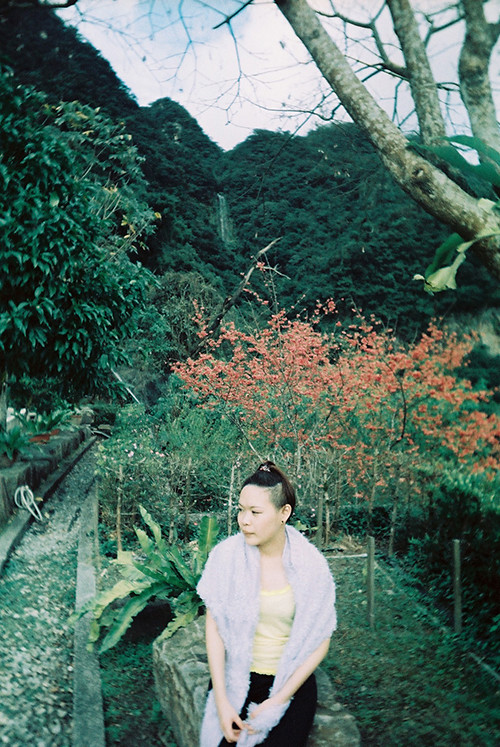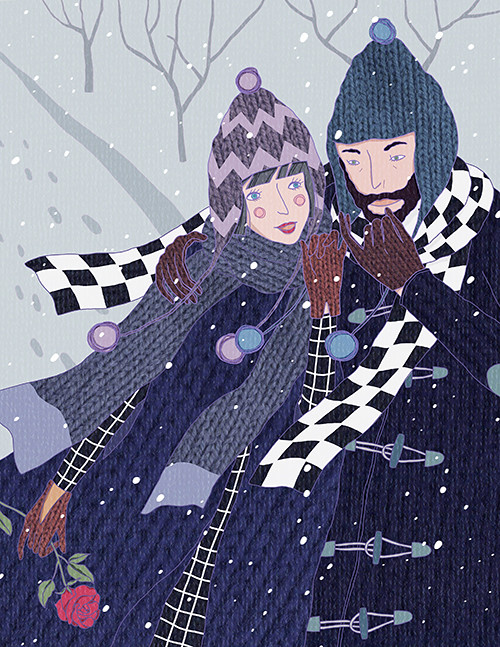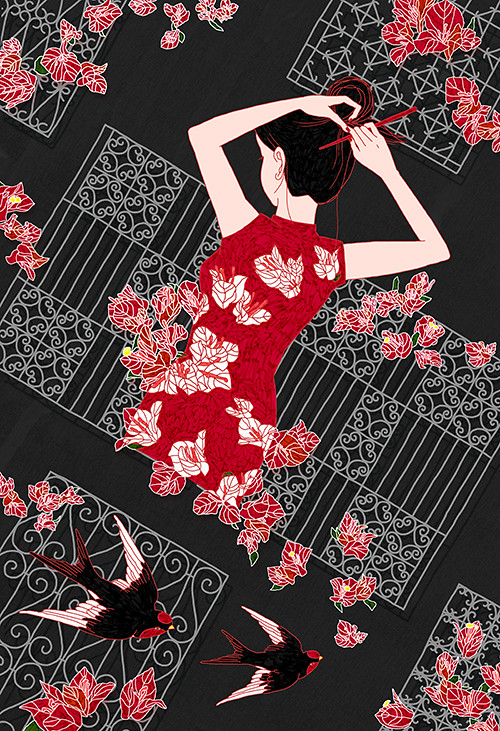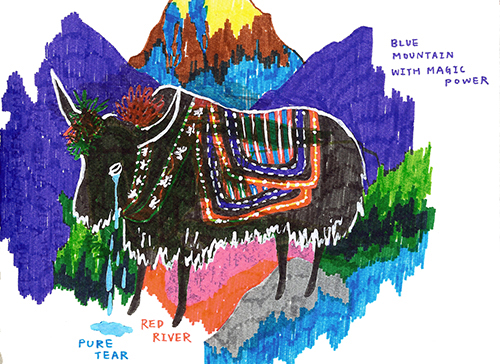Meet Jo Yeh. Jo is one of the participating artists in the 6 Degrees Exhibition and a current MFA student at the Minneapolis College of Art and Design. We were immediately captured by Jo's illustrations, her sense of color, story-telling, and influence of place in her work, and we are excited to share her work and celebrate her unique practice!

Could you tell us a little about yourself and your background?
I was born in Taiwan, a tropical island country in Asia. There, the students’ academic performances in schools mean almost everything, especially in the urban areas, so almost every student has to go to cram schools after school to study more, and has no time to develop personal interests. Luckily, I grew up in a remote countryside in southern Taiwan, so I did not have that much stress. I could spend most of my after-school hours on my interests—reading and drawing—instead of going to cram schools, and here was the start of my art life.
I just received my BFA in communications design from Taiwan’s Shih Chien University in 2013, and I’m currently studying in the MFA program in Minneapolis College of Art and Design, focusing on illustration. When I was in college, I did mostly digital animations and I found myself really enjoying writing scripts and drawing storyboards, and I spent most of my time on those parts of the process. Therefore, after I graduated, I decided to pursue a career as a narrative and story-based illustrator.
Could you tell me about your art practice? What is studio time like for you and where do you find your inspirations?
I try my best to work on something everyday. In general, I have two kinds of working process. Sometimes I start with writing sentences or key words. When I write my ideas down, the images will subsequently appear in my head. Other times, when I have nothing specific, I start with doodling in my sketchbooks. My grandmother was a farmer and when we were living in the countryside, she planted different kinds of vegetables and flowers in our backyard, and I did many sketches of them. I keep this habit even now, I still draw flowers often, and they usually become the patterns in my work. After I moved to the city of Taipei, I carried my sketchbooks with me when I was taking buses or subways, and I drew portraits of random people on public transportations—there are always interesting people doing weird things on subways in every city. So, if I find something with potentials in my sketchbooks, I will develop it further to make it into a complete image. For example, the piece called “You Will Still Be Mine Next Winter” came from such place.
Most of my inspirations come from my daily life. Sometimes the idea just hit me when I am having a casual conversation with my friends, or a friend’s post on Facebook can also bring me some ideas. Because of its colonial past and geographical proximity, Taiwan is deeply affected by Japanese culture, so I also read a lot of Japanese fairy tales, ghost stories and comics, which also serve as inspirations sometimes.

You Will Still Be Mine Next Winter
Can you tell me about the piece you created for the 6 Degrees Exhibition. What is the significance/story behind the image?
“The Southland” is the piece I submitted to the 6 Degrees Exhibition. The elements (window frames, bougainvillea, swallows) in this image are all everyday objects that I could see on the street when I was a little girl. To me, the combination of these elements is a typical image of Taiwan. However, after I moved to the city, these things became more and more rare to see. The woman in the image is my great-grandmother, who passed away when I was in second grade. My memory of her is very blurry, and the only thing I can remember is that she had very long hair, and she always used chopsticks to pin her hair bun. This piece kind of represents my memory of childhood and the early era of Taiwan.

The Southland
It seems that most of your work is inspired by culture, your surroundings, and personal experience. Even viewing your work from home to your life in Minneapolis the color pallet, weather, and scenes in your stories have drastically changed. Can you talk about this relationship of place to piece?
It is a little bit difficult to me to work on themes that have no direct connection/relation to me. As I mentioned, my inspirations come from my daily life, so my work is usually related to the environment I am in, things that happened to me, or some issues I am interested in currently. I project a lot of personal emotions and experiences into my work—For example, It rains a lot in Taipei, so rainy scenes appear in my work quite often when I was living there. Also, the streets in Taipei are full of artificial colors—neon lights, yellow cabs, green and red postal boxes, etc.—so I used bright colors more often before I came to Minneapolis. The snowy winter is a challenge, but also very fresh and new to me as an international student from a tropical country. Therefore, after I moved to Minneapolis, I use colder colors more, such as blue and purple, and snowy sciences start to appear in my work.
All of your work is beautifully made with such a powerful image- they are poetic. Do you have an art philosophy or idea of what art images should include?
In my recent works, I tried to visualize the subtle relationships among people. The themes mostly surround some specific human emotions such as separation, loneliness, longing and yearning. Because of the themes I have chosen, I would say I hope my viewer can feel the same as I do.
You are currently a MFA student at the Minneapolis College of Art and Design. What has that meant for a new community, group of peers, and teachers. Has this drastically affected your work?
Yes. My mentor gives me precise advice as a professional illustrator, which really helps me a lot to improve and create more mature work. Besides, I am happy to be in a brand new learning environment. The way it works in Western culture is quite different from Asian culture; all the teachers and students here at MCAD are very willing to share and discuss ideas and works with each other. It is helpful to gain different feedbacks from different people with different cultural backgrounds and professional areas. Some of the suggestions I received are really out of my expectations and surprised me. I think this is a very precious experience, which allows me to look at my work with different perspectives and even develop newer concepts for my future work.

Blue Mountain with Magic Power
What is the best piece of advice (for creators) that you have ever heard?
I have read an artist’s interview in a book once. The artist was asked the question of when did he start to be an artist, and his answer was that he was already an artist when he made his decision to be one. I think that answer kind of made me determined to be an artist.
This time of year, especially, we are thinking about deadlines, new goals, motivation, and changes. Do you have any goals or projects for the New Year?
I am writing a new story called “Joseph Paul” which talks about the Internet-addicted young generation. The story is almost there but not quite, and creating the illustrations for it is going to be the major project for me in the next few months.
Thanks, Jo! It is incredible to see about your illustrations and transitions in your work, as well as hear your personal ideas of making, influence of location, and story-telling.
You can see more of Jo Yeh's work on her website here. Or see her work for the 6 Degrees Exhibition along with the other 80+ works on the 6 Degrees Digital Gallery or Light Grey Shop.

Could you tell us a little about yourself and your background?
I was born in Taiwan, a tropical island country in Asia. There, the students’ academic performances in schools mean almost everything, especially in the urban areas, so almost every student has to go to cram schools after school to study more, and has no time to develop personal interests. Luckily, I grew up in a remote countryside in southern Taiwan, so I did not have that much stress. I could spend most of my after-school hours on my interests—reading and drawing—instead of going to cram schools, and here was the start of my art life.
I just received my BFA in communications design from Taiwan’s Shih Chien University in 2013, and I’m currently studying in the MFA program in Minneapolis College of Art and Design, focusing on illustration. When I was in college, I did mostly digital animations and I found myself really enjoying writing scripts and drawing storyboards, and I spent most of my time on those parts of the process. Therefore, after I graduated, I decided to pursue a career as a narrative and story-based illustrator.
Could you tell me about your art practice? What is studio time like for you and where do you find your inspirations?
I try my best to work on something everyday. In general, I have two kinds of working process. Sometimes I start with writing sentences or key words. When I write my ideas down, the images will subsequently appear in my head. Other times, when I have nothing specific, I start with doodling in my sketchbooks. My grandmother was a farmer and when we were living in the countryside, she planted different kinds of vegetables and flowers in our backyard, and I did many sketches of them. I keep this habit even now, I still draw flowers often, and they usually become the patterns in my work. After I moved to the city of Taipei, I carried my sketchbooks with me when I was taking buses or subways, and I drew portraits of random people on public transportations—there are always interesting people doing weird things on subways in every city. So, if I find something with potentials in my sketchbooks, I will develop it further to make it into a complete image. For example, the piece called “You Will Still Be Mine Next Winter” came from such place.
Most of my inspirations come from my daily life. Sometimes the idea just hit me when I am having a casual conversation with my friends, or a friend’s post on Facebook can also bring me some ideas. Because of its colonial past and geographical proximity, Taiwan is deeply affected by Japanese culture, so I also read a lot of Japanese fairy tales, ghost stories and comics, which also serve as inspirations sometimes.

You Will Still Be Mine Next Winter
Can you tell me about the piece you created for the 6 Degrees Exhibition. What is the significance/story behind the image?
“The Southland” is the piece I submitted to the 6 Degrees Exhibition. The elements (window frames, bougainvillea, swallows) in this image are all everyday objects that I could see on the street when I was a little girl. To me, the combination of these elements is a typical image of Taiwan. However, after I moved to the city, these things became more and more rare to see. The woman in the image is my great-grandmother, who passed away when I was in second grade. My memory of her is very blurry, and the only thing I can remember is that she had very long hair, and she always used chopsticks to pin her hair bun. This piece kind of represents my memory of childhood and the early era of Taiwan.

The Southland
It seems that most of your work is inspired by culture, your surroundings, and personal experience. Even viewing your work from home to your life in Minneapolis the color pallet, weather, and scenes in your stories have drastically changed. Can you talk about this relationship of place to piece?
It is a little bit difficult to me to work on themes that have no direct connection/relation to me. As I mentioned, my inspirations come from my daily life, so my work is usually related to the environment I am in, things that happened to me, or some issues I am interested in currently. I project a lot of personal emotions and experiences into my work—For example, It rains a lot in Taipei, so rainy scenes appear in my work quite often when I was living there. Also, the streets in Taipei are full of artificial colors—neon lights, yellow cabs, green and red postal boxes, etc.—so I used bright colors more often before I came to Minneapolis. The snowy winter is a challenge, but also very fresh and new to me as an international student from a tropical country. Therefore, after I moved to Minneapolis, I use colder colors more, such as blue and purple, and snowy sciences start to appear in my work.
All of your work is beautifully made with such a powerful image- they are poetic. Do you have an art philosophy or idea of what art images should include?
In my recent works, I tried to visualize the subtle relationships among people. The themes mostly surround some specific human emotions such as separation, loneliness, longing and yearning. Because of the themes I have chosen, I would say I hope my viewer can feel the same as I do.
You are currently a MFA student at the Minneapolis College of Art and Design. What has that meant for a new community, group of peers, and teachers. Has this drastically affected your work?
Yes. My mentor gives me precise advice as a professional illustrator, which really helps me a lot to improve and create more mature work. Besides, I am happy to be in a brand new learning environment. The way it works in Western culture is quite different from Asian culture; all the teachers and students here at MCAD are very willing to share and discuss ideas and works with each other. It is helpful to gain different feedbacks from different people with different cultural backgrounds and professional areas. Some of the suggestions I received are really out of my expectations and surprised me. I think this is a very precious experience, which allows me to look at my work with different perspectives and even develop newer concepts for my future work.

Blue Mountain with Magic Power
What is the best piece of advice (for creators) that you have ever heard?
I have read an artist’s interview in a book once. The artist was asked the question of when did he start to be an artist, and his answer was that he was already an artist when he made his decision to be one. I think that answer kind of made me determined to be an artist.
This time of year, especially, we are thinking about deadlines, new goals, motivation, and changes. Do you have any goals or projects for the New Year?
I am writing a new story called “Joseph Paul” which talks about the Internet-addicted young generation. The story is almost there but not quite, and creating the illustrations for it is going to be the major project for me in the next few months.
Thanks, Jo! It is incredible to see about your illustrations and transitions in your work, as well as hear your personal ideas of making, influence of location, and story-telling.
You can see more of Jo Yeh's work on her website here. Or see her work for the 6 Degrees Exhibition along with the other 80+ works on the 6 Degrees Digital Gallery or Light Grey Shop.
